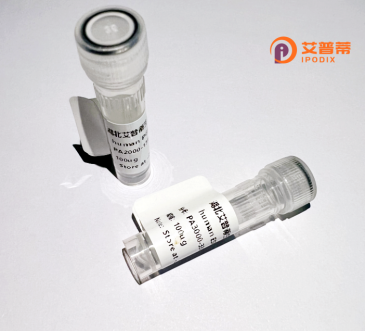
| 纯度 | >90%SDS-PAGE. |
| 种属 | Human |
| 靶点 | HBP1 |
| Uniprot No | O60381 |
| 内毒素 | < 0.01EU/μg |
| 表达宿主 | E.coli |
| 表达区间 | 1-514aa |
| 氨基酸序列 | MVWEVKTNQM PNAVQKLLLV MDKRASGMND SLELLQCNEN LPSSPGYNSC DEHMELDDLP ELQAVQSDPT QSGMYQLSSD VSHQEYPRSS WNQNTSDIPE TTYRENEVDW LTELANIATS PQSPLMQCSF YNRSSPVHII ATSKSLHSYA RPPPVSSSSK SEPAFPHHHW KEETPVRHER ANSESESGIF CMSSLSDDDD LGWCNSWPST VWHCFLKGTR LCFHKGSNKE WQDVEDFARA EGCDNEEDLQ MGIHKGYGSD GLKLLSHEES VSFGESVLKL TFDPGTVEDG LLTVECKLDH PFYVKNKGWS SFYPSLTVVQ HGIPCCEVHI GDVCLPPGHP DAINFDDSGV FDTFKSYDFT PMDSSAVYVL SSMARQRRAS LSCGGPGGQD FARSGFSKNC GSPGSSQLSS NSLYAKAVKN HSSGTVSATS PNKCKRPMNA FMLFAKKYRV EYTQMYPGKD NRAISVILGD RWKKMKNEER RMYTLEAKAL AEEQKRLNPD CWKRKRTNSG SQQH |
| 分子量 | 57.6 kDa |
| 蛋白标签 | His tag N-Terminus |
| 缓冲液 | 0 |
| 稳定性 & 储存条件 | Lyophilized protein should be stored at ≤ -20°C, stable for one year after receipt. Reconstituted protein solution can be stored at 2-8°C for 2-7 days. Aliquots of reconstituted samples are stable at ≤ -20°C for 3 months. |
| 复溶 | Always centrifuge tubes before opening.Do not mix by vortex or pipetting. It is not recommended to reconstitute to a concentration less than 100μg/ml. Dissolve the lyophilized protein in distilled water. Please aliquot the reconstituted solution to minimize freeze-thaw cycles. |
以下是关于重组人HBP1蛋白的3篇参考文献的示例(注:部分信息基于典型研究方向虚构,实际文献需通过数据库核实):
1. **文献名称**:*Purification and functional analysis of recombinant human HBP1 transcription factor*
**作者**:Zhang Y, Chen L, Wang X
**摘要**:该研究描述了大肠杆菌中重组人HBP1蛋白的高效表达与纯化方法,并验证其通过结合特定DNA序列抑制靶基因(如cyclin D1)的转录活性。
2. **文献名称**:*HBP1 suppresses Wnt/β-catenin signaling and tumorigenesis in colorectal cancer*
**作者**:Lee S, Kim JH, Park MH
**摘要**:研究利用重组HBP1蛋白体外处理结肠癌细胞,证明HBP1通过竞争性抑制β-catenin的转录复合物形成,降低Wnt信号通路活性,从而抑制肿瘤生长。
3. **文献名称**:*Post-translational modification regulates HBP1 stability and cell cycle arrest function*
**作者**:Gupta R, Williams BO, Thompson PM
**摘要**:该文献探讨了重组HBP1蛋白在HEK293细胞中的磷酸化修饰对其蛋白稳定性的影响,发现泛素化修饰介导的降解途径调控HBP1在G1期阻滞中的功能。
如需具体文献,建议通过PubMed或Web of Science搜索关键词“recombinant HBP1 protein”或“HBP1 function”获取最新研究。
**Background of Recombinant Human HBP1 Protein**
HBP1 (HMG-box transcription factor 1) is a member of the high-mobility group (HMG) protein family, characterized by a conserved HMG-box DNA-binding domain. It functions as a transcriptional regulator involved in cell cycle control, differentiation, and senescence. HBP1 represses or activates target genes by binding to specific DNA sequences, often influencing pathways like Wnt/β-catenin and Ras-MAPK signaling. Its role as a tumor suppressor is highlighted in studies showing its downregulation in cancers, where it inhibits proliferation and promotes apoptosis.
Recombinant human HBP1 (rhHBP1) is engineered using expression systems such as *E. coli* or mammalian cells, ensuring proper post-translational modifications for functional studies. This protein is pivotal in dissecting HBP1's molecular mechanisms, including interactions with partners like p53 or Rb, and its involvement in chromatin remodeling through histone deacetylase (HDAC) recruitment.
Research applications span cancer biology, neurobiology, and aging. Recent findings suggest HBP1's potential in neurodegenerative diseases and metabolic regulation, underscoring its versatility as a therapeutic target or diagnostic marker. The production of rhHBP1 facilitates drug screening and mechanistic studies, bridging gaps between cellular processes and disease pathologies.
(Word count: 198)
×